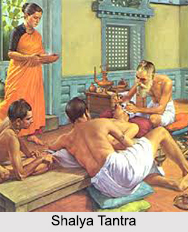 Shalya Tantra is the surgical method which was initiated by Ayurvedic sages in ancient India. Shalya Tantra is the root of modern surgery, a branch of Ayurveda.
Shalya Tantra is the surgical method which was initiated by Ayurvedic sages in ancient India. Shalya Tantra is the root of modern surgery, a branch of Ayurveda.
Ayurveda considers a human body to be developed from five universal factors known as the "Panch Mahabhutas". These are earth (prithvi), water (jal), fire (agni), air (vayu) and universal space (akash). These factors ultimately give rise to the "Tridosha", that are Vata, Pitta and Kapha. These Tridoshas maintain the body"s balance in case of a disproportion in one or more than one of these components, one"s health degenerates and become ill. To a certain extent, the medicinal way of treatment or Kayachikitsa can be applied with good results. But at times the disease goes beyond the control of Kayachikitsa and surgical intervention or Shalya Tantra becomes mandatory.
Etymology of Shalya Tantra
The word "Shalya Tantra" literally signifies the elimination of irritating factors from the human body. "Shalya" means cause, which produces pain, or factor, which stimulates irritation, and "Tantra" means the technique by which this cause or factor is done away with.
Concept of Shalya Tantra by Sushruta
Sushruta was the earliest surgeon to develop cosmetic surgery. Shalya Tantra is discussed in detail in his renowned Ayurvedic text "Sushruta Samhita". Here he gives an exhaustive description of the surgical processes involved in different conditions where surgery is required.
Treatments in Shalya Tantra
Sushruta Samhita explicitly mentions how to deal with different types of tumors, trauma injuries, non-healing wounds, ascites, bone fractures, enlarged lymph nodes, haemorrhoids, prolapsed rectum, stones, urine retention and breast diseases. Moreover, procedures are suggested for dealing with complications during pregnancy and labour or obstructions in the intestinal loop. The surgical instruments used in Shalya Tantra were made from natural substances like branches of trees and broad leaves.
The chief drawback of Shalya Tantra was the lack of proper aseptic precautions at that time. Furthermore, the instruments utilized were unsophisticated and often caused much pain to the patient. In spite of this, the treatment of Shalya Tantra was popular because it was able to provide faster relief than the slow process of recovery from medicines or herbs. But, the long foreign rule in India and lack of proper promotional facilities hindered the advancement of Ayurvedic surgery in the middle of the second millennium.




















